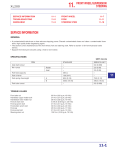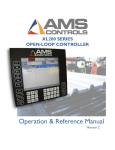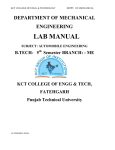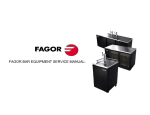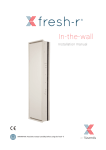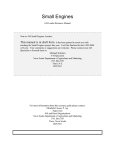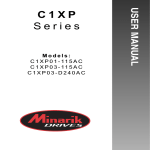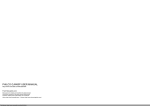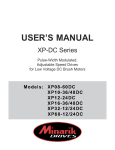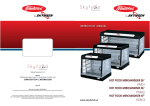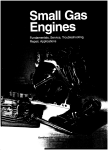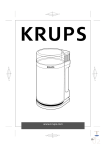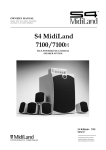Download cylinder head
Transcript
6. XL200 SERVICE INFORMATION TROUBLESHOOTING CYLINDER HEAD COVER/CAMSHAFT REMOVAL CYLINDER HEAD REMOVAL CYLINDER HEAD DISASSEMBLY 6-1 6-2 CYLINDER HEAD/VALVES VALVE GUIDE REPLACEMENT VALVE SEAT INSPECTION/REFACING CYLINDER HEAD ASSEMBLY CYLINDER HEAD INSTALLATION CAMSHAFT/CYLINDER HEAD COVER INSTALLATION 6-3 6-6 6-7 6-9 6-10 6-13 6-14 6-15 SERVICE INFORMATION GENERAL • This section covers service procedure for the cylinder head and valves. • The engine must be removed to service the camshaft, cylinder head, valves and rocker arms. • Camshaft and rocker arm lubrication oil is fed through an oil passage. Be sure the passage is not clogged. • Clean all disassembled parts with clean solvent and dry them by blowing them off with compressed air before inspection. • Pour clean engine oil into the oil pockets in the cylinder head during assembly to lubricate the camshaft lobes. SPECIFICATIONS UNIT: mm (in) ITEM 1.350 kPa (13.5 kg/cm ; 192 psi). — IN. 31.579 - 31.739 (1.243-1.249) 31.30 (1.232) EX 31.419 - 31.579 (1.236-1.243) 31.20 (1.228) — 0.10 (0.004) I.D. 12.000 - 12.018 (0.4724 - 0.4731) 12.05 (0.474) Shaft O.D. 11.977 - 11.995 (0.4715 - 0.4722) 11.93 (0.470) Arm-to-shaft clearance 0,005 - 0,041 (0.0002 - 0.0016) 0.08 (0.003) INNER 39.2 (1.543) 38.0 (1.50) OUTER 44.85 (1.766) 43.5 (1.71) Cylinder head warpage Rocker arm Valve spring free length Valve stem O.D. Valve guide I.D. Stem-to-guide clearance Valve seat width SERVICE LIMIT 2 Cylinder compression Cam lobe height STANDARD IN 5.450 - 5.465 (0.2146 - 0.2152) 5.44 (0.214) EX 5.430 - 5.445 (0.2138 - 0.2144) 5.42 (0.213) IN 5.475 - 5.485 (0.2156 - 0.2159) 5.50 (0.217) EX 5.475 - 5.485 (0.2156 - 0.2159) 5.50 (0.217) IN 0.010 - 0.035 (0.0004 - 0.0014) 0.06 (0.002) EX 0.030 - 0.055 (0.0012 - 0.0022) 0.08 (0.003) 1.1 - 1.3 (0.043-0.051) 1.5 (0.06) 6–1 6 XL200 CYLINDER HEAD/VALVES 10 N.m (1.0 kg.m, 7ft-lb) 27 N.m (2.7 kg.m, 20ft-lb) 15 N.m (1.5 kg.m, 11ft-lb) 12 N.m (1.2 kg.m, 9ft-lb) 14 N.m (1.4 kg.m, 10ft-lb) 10 N.m (1.0 kg.m, 7ft-lb) 4 N.m (0.4 kg.m, 3ft-lb) 12 N.m (1.2 kg.m, 9ft-lb) 10 N.m (1.0 kg.m, 7ft-lb) 8 N.m (0.8 kg.m, 6ft-lb) 6 N.m (0.6 kg.m, 4ft-lb) 6-0 XL200 CYLINDER HEAD/VALVES TORQUE VALUES Valve adjusting hole cap Valve adjusting screw lock nut Cylinder head cover 8 mm cap nut Cylinder head cover 6 mm socket bolt Cam sprocket bolt Cam chain tensioner lifter mounting bolt Cam chain tensioner lifter sealing screw Timing hole cap Crankshaft hole cap 15 N.m (1,5 kg.m, 11 ft-lb) 14 N.m (1,4 kg.m, 10 ft-lb) 27 N.m (2,7 kg.m, 20 ft-lb) 10 N.m (1,0 kg.m, 7 ft-lb) 12 N.m (1,2 kg.m, 9 ft-lb) 12 N.m (1,2 kg.m, 9 ft-lb) 4 N.m (0,4 kg.m, 3 ft-lb) 6 N.m (0,6 kg.m. 4 ft-lb) 8 N.m (0,8 kg.m, 6 ft-lb) TOOLS Valve guide reamer, 5.485 mm Valve guide driver, 5,5 mm Valve spring compressor 07984-0980001 07742-0010100BR 07757-0010000BR TROUBLESHOOTING • Engine top-end problems usually affect engine performance. These can be diagnosed by a compression or leak down test, or by tracing noises to the top-end with a sounding rod or stethoscope. • If the performance is poor at low speeds, check for white smoke in the crankcase breather tube. If the tube is smoky, check for a seized piston ring. Compression too low, hard starting or poor performance at low speed • Valves – Incorrect valve adjustment – Burned or bent valves – Incorrect valve timing – Broken valve spring – Weak valve spring • Cylinder head – Leaking or damaged cylinder head gasket – Warped or cracked cylinder head • Faulty cylinder/piston (Section 7) Compression too high, overheating or knocking • Excessive carbon build-up in cylinder or on top of piston 6-2 Excessive smoke • Worn valve stem or valve guide • Damaged stem seal • Faulty cylinder or piston (Section 7) Excessive noise • Incorrect valve clearance • Sticking valve or broken valve spring • Worn or damaged push rod • Loose or worn cam chain • Worn or damaged cam chain tensioner • Worn cam sprocket teeth • Worn rocker arm and/or shaft • Faulty cylinder or piston (Section 7) Rough idle • Low cylinder compression • Intake air leak XL200 CYLINDER HEAD/VALVES BOLTS CYLINDER HEAD COVER/CAMSHAFT REMOVAL Remove the following: – starter motor – crankshaft/timing hole caps Remove the bolts, cam chain tensioner lifter and gasket. CAM CHAIN TENSIONER INDEX MARK Align the “T” mark on the flywheel with the index mark on the left crankcase cover by turning the crankshaft counterclockwise. “T” MARK CAM SPROCKET COVER Remove the valve adjusting hole caps and make sure the piston is at T.D.C. on the compression stroke by checking for clearance at both rocker arms. If the piston is not at T.D.C. on the compression stroke, rotate the crankshaft 360 degrees counterclockwise and recheck. Remove the cam sprocket cover. Remove the cam sprocket bolts by holding the crankshaft. BOLTS Remove the cam sprocket from the camshaft flange, then remove the cam chain from the sprocket. NOTE • Suspend the cam chain with a piece of wire to prevent it from falling into the crankcase. CAM SPROCKET CAM CHAIN 6-3 XL200 CYLINDER HEAD/VALVES CAP NUT/SEALING WASHER Remove the engine hanger plate. Remove the cylinder head cover cap nuts/sealing washers and flange bolts in a gradual, crisscross pattern. Remove the cylinder head cover. HEAD COVER CAMSHAFT BOLTS DOWEL PIN Remove the camshaft. Remove the dowel pins. NOTE • It is not necessary to force them out. RUBBER PLUG Remove the rubber plug; do not lose it. Clean off any sealant material from the head cover and cylinder head mating surface. CAMSHAFT INSPECTION Turn the outer races of camshaft bearings with your finger. The bearings should turn smoothly and quietly. Also check that the inner races fit tightly on the camshaft. Measure the height of each cam lobe and inspect it for wear or damage. SERVICE LIMIT: Intake: Exhaust: 6-4 31.30 mm (1.232 in) 31.20 mm (1.228 in) XL200 CYLINDER HEAD/VALVES TENSIONER LIFTER TENSIONER LIFTER INSPECTION Remove the cam chain tensioner lifter sealing bolt and O-ring. Check the lifter operation: – the tensioner shaft should not go into the body unless it is pushed. – When it turned clockwise with a screwdriver, the tensioner shaft shoud be pulled into the body. The shaft should spring out of the body as soon as the screwdriver is released. Make a tensioner shaft stopper tool out of a thin piece of steel (0.8 mm thick) using the diagram. PLATE (0.8 mm thick) CYLINDER HEAD COVER DISASSEMBLY Remove the rocker arm shaft plate by removing the setting screw. SCREW ROCKER ARM SHAFT ROCKER ARM Remove the rocker arm shafts by screwing a 6 mm bolt into the threaded ends as shown. Remove the rocker arms. ROCKER ARM/SHAFT INSPECTION Inspect the rocker arm slipper surfaces for excessive wear. Inspect the rocker arms and shafts for wear or damage. 6 mm BOLT ROCKER ARM ROCKER ARM SHAFT NOTE • If the rocker arms require servicing or replacement, inspect the cam lobes for scoring, chipping or flat spots. Measure the I.D. of each rocker arm. SERVICE LIMIT: 12.05 mm (0.474 in) Measure the O.D. of each rocker arm shaft. SERVICE LIMIT: 11.93 mm (0.470 in) Calculate the rocker arm-to-shaft clearance. SERVICE LIMIT: 0.08 mm (0.003 in) 6-5 XL200 CYLINDER HEAD/VALVES CYLINDER HEAD SOCKET BOLT/WASHER CYLINDER HEAD REMOVAL Remove the following: – cylinder head cover – engine from the frame – cylinder head socket bolt/washer – cylinder head GASKET DOWEL PIN – cam chain guide – gasket – dowel pins Clean off any gasket material from the cylinder head and cylinder mating surfaces. CAM CHAIN GUIDE CAM CHAIN TENSIONER Remove the cam chain tensioner. Check the cam chain tensioner for excessive wear or damage. CAM CHAIN GUIDE Check the cam chain guide for excessive wear or damage. 6-6 XL200 CYLINDER HEAD/VALVES PIVOT BOLT/WASHER SOCKET BOLT CYLINDER HEAD DISASSEMBLY Remove the cam chain tensioner pivot bolt, washer and cam chain tensioner. Remove the socket bolts and carburetor insulator. CAM CHAIN TENSIONER INSULATOR While compressing the valve spring with a valve spring compressor, remove the valve cotters. h • To prevent loss of tension, do not compress the valve spring more than necessary to remove the cotters. TOOL: Valve spring compressor SPRING COMPRESSOR VALVE SPRING SEAT INNER SPRING Loosen the valve spring compressor and remove the following: – spring retainers – outer and inner valve springs – spring seats – inlet and exhaust valve NOTE • Mark all disassembled parts to ensure correct reassembly. Remove the carbon deposits from the combustion chamber. Clean off any gasket materials from the cylinder head surface. STEM SEAL OUTER SPRING SPRING RETAINER INSPECTION CYLINDER HEAD Check the spark plug hole and valve area for cracks. Check the cylinder head for warpage with a straight edge and a feeler gauge. SERVICE LIMIT: 0.10 mm (0.004 in) 6-7 XL200 CYLINDER HEAD/VALVES VALVE Inspect the valve for trueness, burning, scratches or abnormal stem wear. Measure the valve stem O.D. SERVICE LIMIT: In: 5.44 mm (0.214 in) Ex: 5.42 mm (0.213 in) Insert each valve into the valve guide and check the valve movement in the guide. VALVE GUIDE REAMER VALVE GUIDE NOTE • Ream the valve guide to remove the carbon build-up before checking the valve guide. • Always rotate the reamer clockwise, never couterclockwise when installing, removing and reaming. Measure and record each valve guide I.D. with a ball gauge or inside micrometer. SERVICE LIMIT: IN/EX: 5.50 mm (0.217 in) Calculate the stem-to-guide clearance. SERVICE LIMIT: IN: 0.06 mm (0.002 in) EX: 0.08 mm (0.003 in) NOTE • If the stem-to-guide clearance exceeds the service limit, determine if a new guide with standard dimensions would bring the clearance within tolerance. If so, replace the guides as necessary and ream to fit. • If the stem-to-guide clearance still exceeds the service limit with new guides, replace the valve guide reamers • Reface the valve seat whenever new valve guides are installed. 6-8 XL200 CYLINDER HEAD/VALVES VALVE SPRING Measure the valve spring free length. SERVICE LIMIT: Inner: Outer: 38.0 mm (1.50 in) 43.5 mm (1.71 in) VALVE GUIDE DRIVER VALVE GUIDE REPLACEMENT Chill valve guides in the freezer section of a refrigerator for about an hour. Heat the cylinder head to 100°C with a hot plate or oven. t • To avoid burns, wear heavy gloves when handling the heated cylinder head. h • Do not use a torch to heat the cylinder head; it may cause warping. Support the cylinder head and drive out the valve guide from the valve port with a valve guide driver. h • Avoid damaging the cylinder head. TOOL: Valve guide driver, 5.5 mm VALVE GUIDE DRIVER Place a new O-ring on the new valve guide. Install a valve guide from the top of the cylinder head. h • When installing a valve guide, take care not to damage the cylinder head. TOOL: Valve guide driver, 5,5 mm 6-9 XL200 CYLINDER HEAD/VALVES VALVE GUIDE REAMER After driving in the valve guide, ream it with a valve guide reamer. NOTE • Use cutting oil on the reamer during this operation. • Always rotate the reamer clockwise, never counterclockwise. Clean the cylinder head thoroughly to remove any metal particles. Reface the valve seat. VALVE SEAT INSPECTION/REFACING VALVE SEAT INSPECTION Clean the intake and exhaust valves thoroughly to remove the carbon deposits. Apply light coating if Prussian Blue to the valve seats. Lap the valves and seats using a rubber hose or other hand lapping tool. Remove the tool and inspect the width of each valve seat. STANDARD: 1.1 - 1.3mm (0.04 - 0.05 in) SERVICE LIMIT: 1.5 mm (0.06 in) (1) SEAT WIDTH If the valve seat is too wide, too narrow or has low spots, the seat must be ground. h • The valve cannot be ground. If a valve face is burned or badly worn or it contact the seat unevenly, replace the valve. 6-10 XL200 CYLINDER HEAD/VALVES VALVE GUIDE REAMER VALVE SEAT GRINDING Honda Valve Seat Cutters, a grinder or equivalent valve seat refacing equipament are recommended to correct a worn valve seat. NOTE • Follow the refacer manufacturer’s operating instructions. Use a 45 degree cutter to remove ant roughness or irregularities from the seat. NOTE • Reface the valve seat with a 45 degree cutter when a valve guide is replaced. Using 32 degree cutter, remove 1/4 of the exiting valve seat material. 6-11 CYLINDER HEAD/VALVES Using 60 degree cutter, remove the bottom 1/4 of the oil seat. Remove the cutter and inspect the area you have just removed. Install a 45 degree finish cutter and cut the seat to proper width. Make sure that all pitting and irregularities are removed. Refinish if necessary. STANDARD SEAT WIDTH: 1.1 - 1.3 mm (0.04-0.05 in) Apply thin coat of Prussian Blue to the valve seat. Press the valve through the valve guide and onto the seat to make a clear pattern. NOTE • The location of the valve seat in relation to the valve face is very important for good sealing. If the contact area is too high on the valve, the seat must be lowered using a 32 degree flat cutter. If the contact area is too low on the valve, the seat must be raised using a 60 degree inner cutter. 6-12 XL200 XL200 CYLINDER HEAD/VALVES Refinish the seat to specifications, using a 45 degree finish cutter. After cutting the seat, apply lapping compound to the valve face, and lap the valve using light pressure. After lapping, wash all residual compound off the cylinder head and valve. STEM SEAL CYLINDER HEAD ASSEMBLY Install the inner and outer valve spring seats and new valve stem seals. VALVE SPRING SEAT INNER SPRING Lubricate each valve stem with engine oil. Insert the intake and exhaust valve into the valve guides. Install the valve spring seats, springs and retainers. NOTE • Install the valve springs with the narrow pitch end facing the combustion chamber. STEM SEAL OUTER SPRING SPRING RETAINER Compress the valve spring and install the valve cotters. h • To prevent loss of tension, do not compress the valve spring more than necessary. TOOL: Valve spring compressor SPRING COMPRESSOR 6-13 XL200 CYLINDER HEAD/VALVES Tap the stems gently with a plastic hammer to firmly seat the cotters. h • Support the cylinder head above the work bench surface to prevent valve damage. O-RING Check the insulator O-ring is in good condition, replace if necessary. Tighten the insulator socket bolt securely. INSULATOR PIVOT BOLT/WASHER SOCKET BOLT Install the cam chain tensioner, washer and pivot bolt. Tighten the pivot bolt to the specified torque. TORQUE: 10 N.m (1.0 kg.m, 7 ft-lb) CAM CHAIN TENSIONER CAM CHAIN GUIDE CYLINDER HEAD INSTALLATION Place the bottom end of the cam chain guide into the groove in the left crankcase, and its bosses in the grooves in the cylinder upper surface. NOTE • Make sure that the cam chain is properly installed on the timing sprocket as shown. ALIGN 6-14 XL200 CYLINDER HEAD/VALVES DOWEL PIN GASKET Clean the cylinder head gasket surface of any gasket materials. NOTE • Do not allow dust and dirt to enter the engine. Install the dowel pins, new O-ring and new cylinder head gasket. CYLINDER HEAD Install the cylinder head Install a new sealing washer and the tensioner pivot bolt through the tensioner hole. Tighten the bolt to the specified torque. TORQUE: 10 N.m (1.0 kg.m, 7 ft-lb) SOCKET BOLT/WASHER ROCKER ARM ROCKER ARM SHAFT CAMSHAFT/CYLINDER HEAD COVER INSTALLATION CYLINDER HEAD COVER ASSEMBLY Apply oil to the rocker arm shafts. Install the rocker arms and rocker arm shafts in the cylinder head cover. With the rocker arm shaft reliefs on the inside, install the rocker arm shaft plate. Tighten the setting screw securely. SCREW PLATE CAMSHAFT/CYLINDER HEAD COVER INSTALLATION Install the dowel pins and rubber plug. RUBBER PLUG DOWEL PINS 6-15 XL200 CYLINDER HEAD/VALVES CAMSHAFT Apply oil to the cam lobes and camshaft bearings. Install the camshaft in the cylinder head, positioning the cam lobes down as shown. Pour fresh oil into the oil pocket in the cylinder head until the cams are submerged. HEAD COVER Apply sealant to the mating surface of the cylinder head cover. h • Do not apply sealant to the oil passage. Install the head cover onto the cylinder head. SEALANT Apply oil to the cap nut threads. Install the new sealing washers/cap nuts and flange bolts. Tighten the cap nut in a crisscross pattern in 2-3 steps. CAP NUT/WASHER TORQUE: 27 N.m (2.7 kg.m, 20 ft-lb) Tighten the flange bolts and setting bolt in a gradual crisscross pattern. TORQUE: 10 N.m (1.0 kg.m, 7 ft-lb) BOLT Align the “T” mark on the flywheel with the index mark on the left crankcase cover by turning the crankshaft counterclockwise. (1) INDEX MARK (2) “T” MARK 6-16 XL200 CYLINDER HEAD/VALVES CAM CHAIN Install the cam sprocket with its timing marks facing out. Install the cam chain over the sprocket as shown. NOTE • If it is difficult to install the chain over the sprocket, make sure the chain is set properly on the timing sprocket. CAM SPROCKET BOLTS Align the timing marks on the cam sprocket with the mating surface of the cylinder head and cover, without rotating the crankshaft. Apply oil to the cam sprocket bolts and install them. Tighten the bolts to the specified torque. TORQUE: 12 N.m (1.2 kg.m, 9 ft-lb) TIMING MARKS TENSIONER LIFTER SCREWDRIVER Turn the tensioner shaft clockwise with a small screwdriver to retract the tensioner, and hold it in the fully retracted position. NOTE • The tensioner will forced out by the spring when it is released. Wedge the tensioner shaft with a piece of wire to hold the tensioner. GASKET TENSIONER LIFTER Install a new gasket on the cam chain tensioner lifter and install it. 6-17 XL200 CYLINDER HEAD/VALVES SOCKET BOLT SCREW Tighten the cam chain tensioner lifter mounting bolts. TORQUE: 12 N.m (1.2 kg.m, 9 ft-lb) Remove the wire holder piece from the tensioner lifter. Install and tighten the screw with a new O-ring. Tighten the screw to the specified torque. TORQUE: 4 N.m (0.4 kg.m, 3 ft-lb) Rotate the crankshaft counterclockwise a few times and recheck the valve timing. O-RING Install a new gasket and O-ring onto the sprocket cover. Install the sprocket cover with its oil pocket facing down as shown. Install and tighten the cover bolts securely. Apply clean engine oil to the O-rings of the adjusting hole caps. CAM SPROCKET COVER BOLTS Install and tighten the cap bolts. TORQUE: 15 N.m (1.5 kg.m, 11 ft-lb) TIMING HOLE CAP Install and tighten the timing hole cap and crankshaft hole cap. TORQUE: Timing hole cap: 6 N.m (0.6 kg.m, 4 ft-lb) Crankshaft hole cap: 8 N.m (0.8 kg.m, 6 ft-lb) Install the following: – starter motor – engine CRANKSHAFT HOLE CAP 6-18 XL200 CYLINDER HEAD/VALVES NOTAS 6-19 GENERAL INFORMATION HOW TO USE THIS MANUAL CONTENTS This service manual describes the service procedure for the XL200. • Throughout the manual, the following abbreviations are used to identify individual models. Code DK 2LA Area (type) General Type Latin America Follow the Maintenance Schedule (Section 3) recommendations to ensure that the vehicle is in peak operation condition. Section 1 through 3 apply to the whole motorcycle, while section 4 through 18 describe parts of the motorcycle, grouped according to location. ENGINE Performing the first scheduled maintenance is very important. It compensates for the initial wear that occurs during the break-in period. GENERAL INFORMATION 1 LUBRICATION 2 MAINTENANCE 3 FUEL SYSTEM 4 ENGINE REMOVAL/INSTALLATION 5 CYLINDER HEAD/VALVES 6 CYLINDER/PISTON 7 CLUTCH/GEARSHIFT LINKAGE 8 ALTERNATOR/STARTER CLUTCH 9 Find the section you want on this page, then turn to the table of contents on page 1 of that section. Most sections start with an assembly or system illustration, service information and troubleshooting for the section, the subsequent pages give detailed procedures. ELECTRIC STARTER All information, illustrations, directions and specifications included in this publication are based on the latest product information available at the time of approval for printing. MOTO HONDA DA AMAZÔNIA LTDA. Reserves the right to make changes at any time without notice and without incurring any oblication whatever. Not part of this publication may be reproduced without written permission. FRAME If you don’t know the source of the trouble, go to section 20 TROUBLESHOOTING. CRANKSHAFT/KICKSTARTER/ TRANSMISSION 10 FRONT WHEEL/SUSPENSION/STEERING 11 REAR WHEEL/SUSPENSION 12 HYDRAULIC BRAKE 13 FAIRING/EXHAUST SYSTEM 14 CHARGING SYSTEM 15 IGNITION SYSTEM 16 ELECTRIC STARTER 17 LIGHTS/METERS/SWITCHES 18 WIRING DIAGRAM 19 TROUBLESHOOTING 20





















